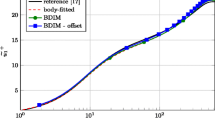Abstract
A turbulent boundary layer manipulated by outer-layer devices has been studied. Experiments have been conducted in the 0.70 by 0.50 m2 low speed wind tunnel of the ‘Modesto Panetti’ Aeronautical Laboratory of the Politecnico di Torino. Mean values and turbulent quantities measured in the natural and manipulated boundary layers are shown for comparison. The mechanisms to explain the observed skin friction and turbulence reduction are discussed. The manipulator wake effect, consisting in decoupling the wall-region from the boundary layer outer-region, is stressed in the present results.
Sommario
Viene studiato uno strato limite turbolento manipolato, utilizzando la tecnica degli ‘outer-layer devices’. Gli esperimenti sono stati condotti nella galleria del vento 0.70×0.50 m2 del Laboratorio di Aeronautica ‘Modesto Panetti’ del Politecnico di Torino. Sono confrontati risultati relativi ai casi di flusso non manipolato e manipolato. Vengono discussi i meccanismi che conducono alla riduzione dello sforzo di attrito a parete e delle quantità turbolente; in particolare si punta l'attenzione sull'effetto decorrelante della scia del manipolatore.
Similar content being viewed by others
References
Bushnell, D.M. and Hefner, J.N., ‘Viscous drag reduction in boundary layer’,Progress in Astronautics and Aeronautics, vol.123, AIAA Inc. Publishers, 1990.
Yajnik, K.S. and Acharya, M.,Non Equilibrium Effects in a Turbulent Boundary Layer Due to the Destruction of Large Eddies, National Aeronautical Laboratory, Bangalore, NAL-BL-7, 1977.
Corke, T.C., Nagib, H.M. and Guezennec, Y.,A new view of the origin, role and manipulation of large scales in turbulent boundary layers, NASA CR 165861, 1982.
Hefner, J.N., Weinstein, L.M. and Bushnell, D.M., ‘Large eddy break-up scheme for turbulent viscous drag reduction’,Viscous Flow Drag Reduction, vol.72, Int.Symp. on Viscous Drag Reduction, Dallas, Texas, November 1979, pp. 110–127.
Bertelrud, A., Truong, T.V. and Avellan, F.,Drag reduction in turbulent boundary layers using ribbons, AIAA-82-1370, 1982.
Savill, A.M. and Mumford, J.C., ‘Manipulation of turbulent boundary layers by outer-layer devices: skin friction and flow visualization results’,J.Fluid Mech., vol.191, (1988), pp.389–417.
Cousteix, J., Coustols, E. and Arnal, D., ‘Controle et modification de la turbulence’,Agard Conference Proceedings No.438, Cesme 1988, pp. 1–34.
Anders, J.B., ‘Outer layer manipulators for turbulent drag reduction’,Progress in Astronautics and Aeronautics, 123, AIAA Inc. Publishers, (1990), pp. 263–284.
Coustols, E., and Savill, A.M., ‘Turbulent skin friction drag reduction by active and passive means’,Agard-R-786, 1992, pp. 55–80.
Hefner, J.N., Weinstein, L.M. and Bushnell, D.M., ‘Large eddy break-up scheme for turbulent viscous drag reduction’,Progress in Astronautics and Aeronautics, vol. 72, AIAA Inc. Publishers, 1980, pp. 110–127.
Bradshaw, P., ‘The turbulent structure of equilibrium boundary layer’,J.Fluid Mech., 29, (1967), 625–645.
Hefner, J.N., Anders, J.B. and Bushnell, D.M.,Alteration of outer flow structures for turbulent drag reduction, AIAA Paper 83-0293, 1983.
Dowling, A.P., ‘The effect of large eddy break-up devices on oncoming vorticity’,J. Fluid Mech., 160, (1985) pp. 447–463.
Head, M.R. and Bandyopadhyay, P.R., ‘New aspects of turbulent boundary layer structure’,J.Fluid Mech., 107, (1981), pp. 297–338.
De Ponte, S., Iuso, G. and Oggiano, M.S., ‘On the measurements of the skin friction in 3D flows. Application to a complete 3D shear layer flow’,18th ICAS, Beijing, September 1992, pp. 1417–1425.
Nguyen, V.D., Savill, A.M. and Westphal, R.V., ‘Skin friction measurements following manipulation of a turbulent boundary layer’,AIAA J., 25-(3), (1987), pp. 498–500.
Rodi, W., ‘A new method of analyzing hot wire signals in highly turbulent flow, and its evaluation in a round jet’,Disa Information No. 17, (1975), pp. 9–18.
Guezennec, Y. and Nagib, H.M., ‘Mechanisms leading to net drag reduction in manipulated turbulent boundary layers’,AIAA J., 28-(2), (1990), pp. 245–252.
Kwing-So Choi, ‘Near wall structure of a turbulent boundary layer with riblets’,J.Fluid Mech., 208, (1989), pp. 417–458.
Lumley, J.L., ‘Drag reduction in turbulent flow by polymer additives’,J.Polymer Sci. Rev.,7 (1973), 263.
Author information
Authors and Affiliations
Rights and permissions
About this article
Cite this article
Iuso, G., Onorato, M. Turbulent boundary layer manipulation by outer-layer devices. Meccanica 30, 359–376 (1995). https://doi.org/10.1007/BF00993419
Received:
Accepted:
Issue Date:
DOI: https://doi.org/10.1007/BF00993419




